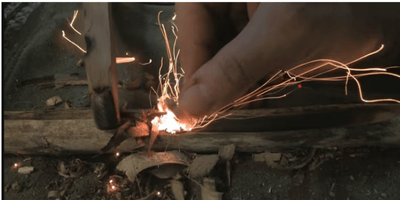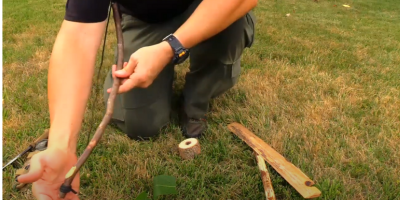
Fire Building
Fire is essential for warmth, and food and water preparation.
Building a fire isn’t difficult – choose a spot close enough to your bed so that it keeps you warm throughout the night. Then, gather dry leaves, grasses, tree bark and twigs, stacking them on top of one another in that order. Above them, construct a makeshift pyramid from larger twigs and sticks. Once you have that burning, just put larger branches on top and keep fueling the fire.
The issue is – how do you light a fire without a lighter. Pretty much the only way you can light a fire without a lighter, matches, flint, gunpowder, or string is with a fire plough.
Take a flat piece of wood and cut a soft groove across it. Place soft, dry grasses at one end. Take another piece of dry wood – preferably a stick – and plough it up and down the groove. You should know in advance that this process is very tiring and painful, and it’ll have you sweating for a long time – sometimes up to an hour. The friction, however, will eventually create tinder, which you can use to light the grasses, and then use that to light your fire.
Finding Your Way Out
When going on a hike or a camping trip, you should always inform someone reliable of your route and tell them to call emergency services if they don’t hear from you in time. This is why experts always recommend checking in with a friend or family member.
If this is the case, then you shouldn’t stray away from the location you were at when you realized you were lost. Rescue services will comb your route looking for you, and they’ll also look at nearby places.
It’s possible that you’ll spot search and rescue before they spot you – shout out at them (whistles are even better) or light a big fire to signal your location (fresh, thick leaves will create thick smoke, which is great for signaling). If you hear a helicopter, run into an open field where they can see you – if possible, wave brightly-colored clothing at them to spot you (red is ideal).
However, if you’ve been waiting for a reasonable length of time (this depends on your route and how long and complicated it is – anything from days to weeks) and no help has arrived, it’s time to save yourself!
Regardless of rescue services, you should move if you’re in a dangerous situation, such as realizing you’re in a predator’s territory, or getting caught in rising waters or in a snowstorm. You should not move on your own during particularly bad weather, nighttime, or if you’re tired or sick. When looking for help on your own, try finding a trail in the woods. A trail is good! It means someone was here already and people frequently cross that path!
It’s always smart to walk downhill and close to water, as people tend to settle in valleys and closer to water. Every time you make a decision (such as taking a left turn, instead of a right) mark the area somehow – create a rock pile, for example. This way, you’ll be able to track back if you made a mistake.
This is, unfortunately, pretty much all you can do. As mentioned earlier, it’s highly likely that you’ll get picked up by mountain rescue, but if you don’t, your best bet is to move camp downhill and downstream, listening and looking for signs of a nearby settlement.
Something that’s often overlooked is just how depressing and horrifying it can be to be stranded alone in the woods. However, you must stay positive and believe that you’ll find help in order to survive. There are records of people surviving for months in the wild, and there’s nothing to say that you can’t do the same.
Survivalist and US Marshal Alex Coker's videos below demonstrate starting a fire with a plow and a bow drill.
Military survivalist Alex Coker demonstrates how to use a fire plow to start a fire with no other tools besides a knife.
Watch Video
In this video, Alex Coker uses another technique called a bow drill to start a fire. This approach requires a string or piece of twine to accomplish.
Watch Video